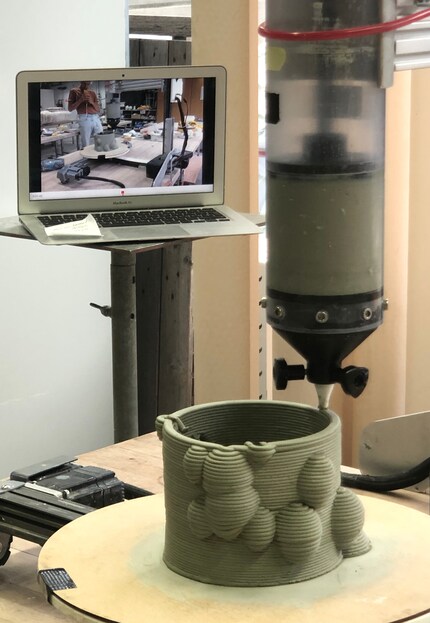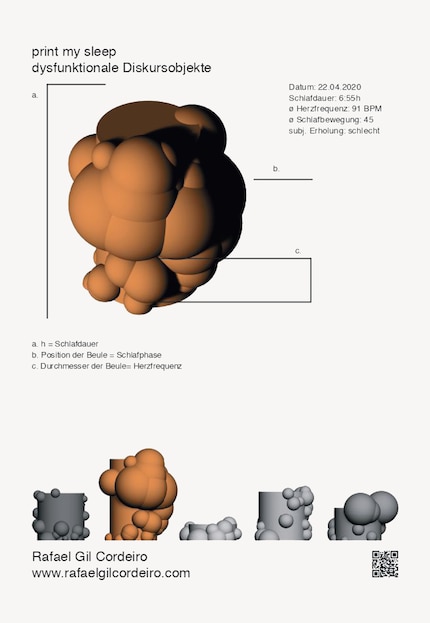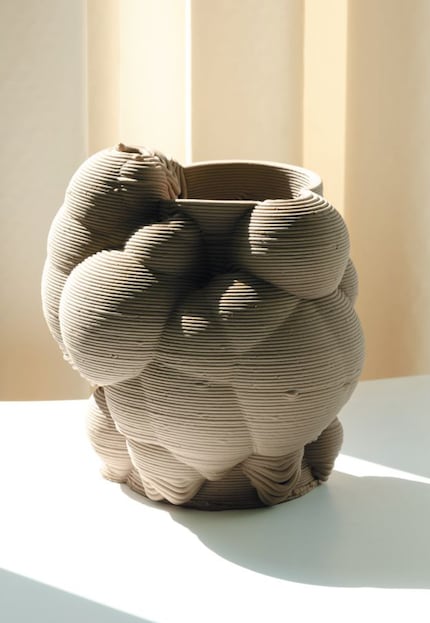
"Print My Sleep:" Objects designed during sleep
Rafael Gil Cordeiro's work shows how your sleep can become design. The designer tracks his sleep and uses the data to create 3D-printed objects. A visualisation of the moment we give up control.
Rafael Gil Cordeiro is one of the only students I know who was able to sleep for their degree. And not just at night, but also during the day. Rafael used tracking to transform his sleep data into design objects for his final project on the Bachelor's degree programme in Trends and Identity at Zurich University of the Arts. Over coffee, he explains to me why he calls them dysfunctional and why he is no longer afraid of sleepless nights.
What's behind your bachelor's thesis?
Rafael Cordeiro: "Print My Sleep" visualises my sleep, which I recorded using Sleep Tracker. The data is converted into ceramic objects using a 3D printer. Each sculpture in the series represents a sleep phase and takes its shape from the recorded data such as pulse, oxygen saturation or movement. They are dysfunctional because, unlike most sleep products on the market, they are not designed to optimise sleep.

Where did your interest in sleep come from?
Last autumn semester, I took part in the ZHdK's "Transcultural Collaboration" exchange programme and spent four months in Hong Kong and Shanghai. I realised for the first time that we don't all sleep the same. There I observed how people set up their sleeping places everywhere and how people sleep in public at all times - especially in the underground. People use their commuting time to occupy themselves, eat or even sleep. That fascinated me. Sleeping during the day is often seen as wasted time in this country. We don't just do nothing in our sleep. The recovery phase is important to prepare us for the waking state. I wanted to find out what was working inside me during this time.
How did you go about immersing yourself in the topic?The concept of "Print My Sleep" was preceded by theoretical work in which I critically questioned the economisation of sleep. In the holistic optimisation society, we not only increasingly look after our appearance, but also focus on rest and relaxation. This can also be seen in the wellness market. The economy is now interested in ensuring that I sleep well and sees potential in the launch of products such as light alarm clocks or sleep aids to appeal to healthy sleepers too. However, new problems can also arise when trying to optimise. I always focus on something that first points out to me that something is "not right".
«Since sleep has become the subject of economic and social debate, it has found no peace. Print My Sleep liberates it from the paradigm of optimisation and idealisation.»
Do you have an example of this?
When recording my sleep for practical work, for example, the sleep tracker told me in the morning that I had moved too much and didn't have a restful night. But I felt fine. The sleep tracker evaluates based on standardised parameters. In our society, we often try to categorise things that are actually uncontrollable and very individual. The subjective part and how I think I slept is often underestimated. In sleep research, it is said that the way you get up and feel is also the quality of your sleep. Even if the app's values tell you the opposite.
For my theoretical employees, I spoke to expert Daniela Janssen from the Centre for Sleep Medicine at the Hirslanden Clinic. She said that the tracking trend means that people often come to her who suspect they have a sleeping disorder based on the data. Of course, you can say that this is not all bad. Sleep trackers can perhaps help to find out whether something is wrong. I don't want to criticise them for that, but rather use them for myself.
The doors of the ZHdK were closed due to the corona crisis. Did that have an impact on your work?
It definitely did. Today I deliberately talk about sleep phases and not nights. I think if I'd had a more regular daily routine, my sleep would have been different. Working from home, like so many others, meant that I got more and more away from the usual seven to eight hours of sleep at night. I was able to decide more individually when and how I wanted to recover. One of the objects represents a siesta, for example.
«We no longer work and sleep like we did fifty years ago. I'm no longer afraid of sleepless nights because good sleep doesn't just have to happen then and even short periods of sleep can be restorative.»
Which sleep tracker did you use?
Trackers such as Fitbit are particularly recommended in connection with sport. That's why I opted for the Sleepon tracker, which was developed in California just for recording sleep. It resembles a thimble and the recorded data and tips are displayed on the smartphone via the app.

What did you do with the data afterwards?
In order to better understand what the tracker measures and how data changes during a sleep phase, I wanted to translate the technical data into three dimensions. So I first had to sleep for a week (laughs). Then I worked with Kevin Hinz, who is an architect and knows a thing or two about visualisations and interaction design.
We used the programme Rhino 3D with the additional programme Grasshopper 3D to convert the measured sleep data into a user-defined form language from which a generative design can be created. Rhino 3D is used to draw the 3D renderings. Grasshopper can be used to feed in data and create a kind of tree diagram. In architecture, this programme is often used to generate complex shapes and structures.
What do the parameters consist of?
The sleep duration equals the object height and the bulge equals the sleep phase. In dream research, you can see in nightmares that the heart rate goes up and there are spikes. With my objects, these are the bumps whose diameters show the heart rate in this phase.
Were the objects printed while you were sleeping?
No, only afterwards. But my utopia was actually that they would be printed while I was asleep and that I would see the result when I got up. But even a 3D printing process needs to be monitored, as every little grain and every air bubble can disrupt the process. In an exhibition context, live translation would certainly have been possible.

Why did you choose ceramic?Ceramic sets the pace. From the moment you hold the modelling clay in your hand, knead it and fire it, you don't know whether the object will crack, the glaze will smudge or whether the drying process will work. You can't control the process from the liquid material to the dry object on the shelf 100 per cent. For me, this is the one-to-one translation to sleep. I also love how the material can now be processed using a 3D printer instead of the traditional method of using a turntable and by hand.
Who is Print My Sleep for?
The concept is aimed at anyone who wants to take a closer look at their sleep or be surprised. With background information, the design objects can open up the discourse and without, they confuse you with their aesthetics, which you don't recognise from everyday life. I believe that the concept still has potential and I would like to use other sleep data, such as yours, so that you learn something new about yourself. You might be wondering how your dog or goldfish sleeps. Although Print My Sleep is based on technical data, it has a personal and poetic touch.
What have you found out about your sleep so far?
That I am an owl. In sleep research, the analogy to animals is used to categorise whether you are more of a morning or evening person. Evening people are owls because they are more tired in the morning. Larks are early risers who, conversely, like to go to bed early.

How do you feel about Sleepon now owning your sleep data?
I haven't thought about that yet. I'm fascinated by the use of data. Even if I sometimes don't know why and what the motivation behind it is, I accept the consequences of digitalisation and actively use it for my work.
What's next for Print My Sleep?
In a design context, there might be the possibility of developing the Print My Sleep concept further in order to offer it as a service. But first I'm looking into whether this interface between science and design can be valuable for sleep research, for example with my interview partner Daniela Janssen in a scientific context. I believe that even in a digitalised society, materiality has the potential to make facts more tangible and therefore easier to communicate.
Like a cheerleader, I love celebrating good design and bringing you closer to everything furniture- and interior design- related. I regularly curate simple yet sophisticated interior ideas, report on trends and interview creative minds about their work.
From the latest iPhone to the return of 80s fashion. The editorial team will help you make sense of it all.
Show all